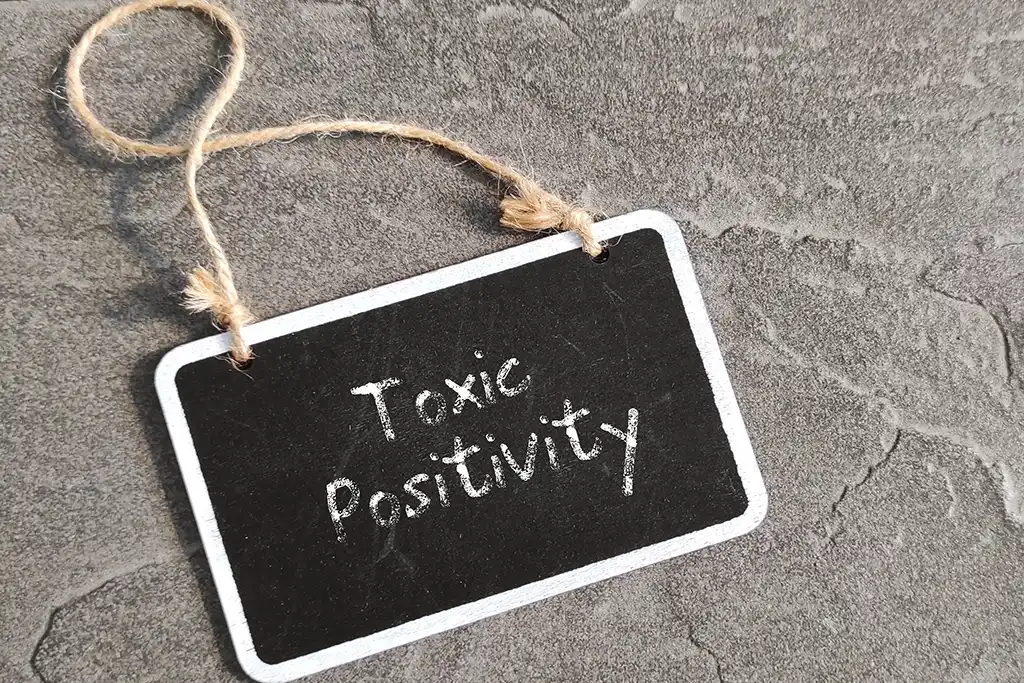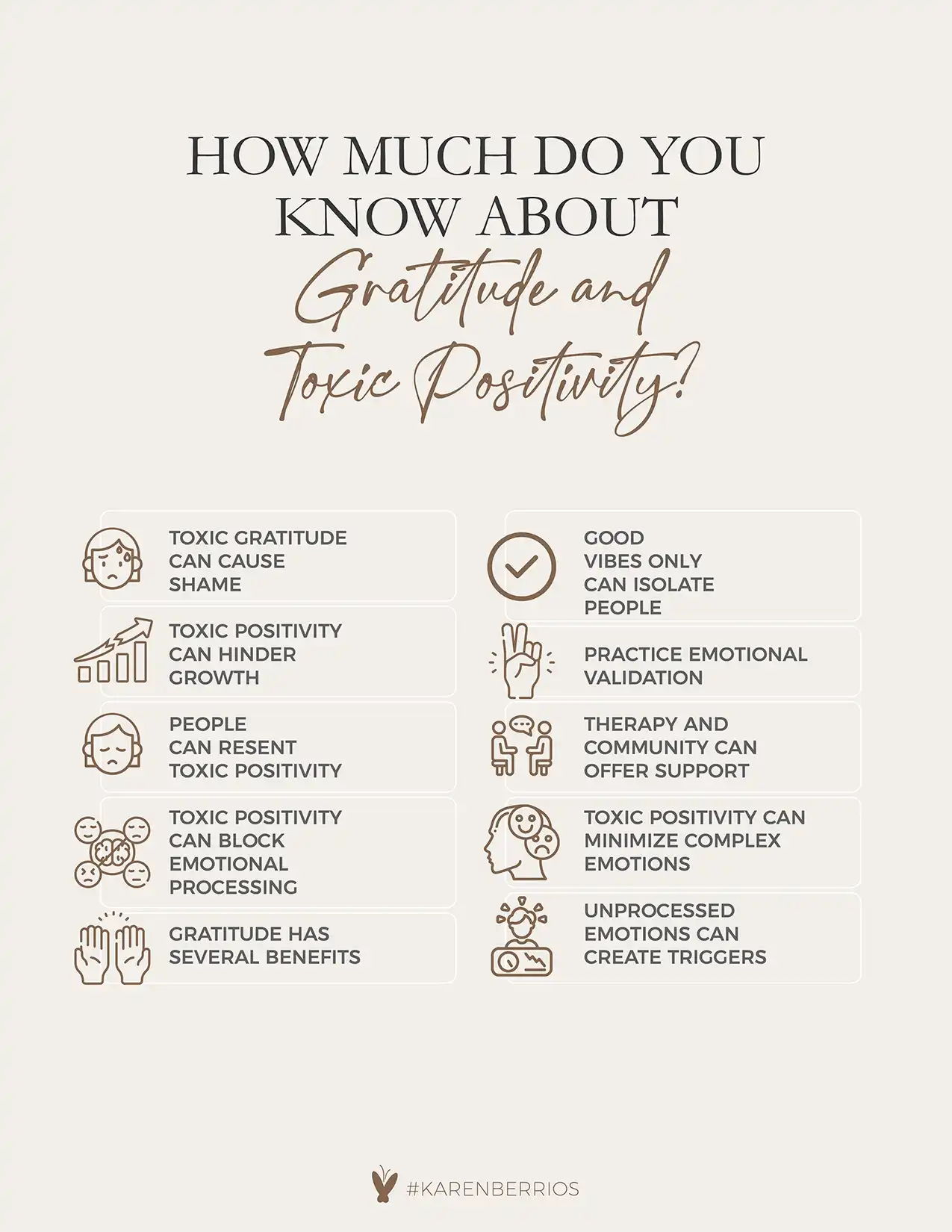

What Are Toxic Gratitude and Toxic Positivity?
What Are Toxic Gratitude. Gratitude and positive thinking are key elements of a happy life. In modern times, these concepts have become more accessible and easy to digest. However toxic gratitude and positivity (as well as spiritual bypassing) have become more widespread. For instance, it’s uncommon to go online, or visit social media without seeing reminders to be happy and smile regardless of what we are going through. Additionally, we see messages of thinking positively specifically to reduce discomfort, or being happy despite deeper feelings of pain or anger.
There are even ideas that anger is a negative emotion and we should shift our emotions to a positive state. Last, but not least, it is also common to see messages encouraging people to be grateful for everything they have and experience. This can include being grateful for the blessings, but also the misfortunes and hardships they have faced. This is known as toxic positivity.
On the other hand, toxic gratitude promotes a similar awareness of hardship. But sometimes there’s less of a positive tone and one of accepting and diminishing. The toxic aspect of it is it’s forced and invalidating. Imagine someone breaking into a car and stealing valuable items. Someone forcing gratitude can try to comfort the person whose car and items were vandalized by saying, “Be grateful they didn’t take your car.”
While this is true, the opportunity for the car owner to experience empathy and emotional processing is lost. As a result they may feel even more upset because someone is telling them what to be grateful for when they didn’t experience the loss.
What Does Toxic Positivity Look and Sound Like?
Toxic positivity is well intended. Many times, the advice to let go of anger comes from a good place. In fact, holding on to stress and anger can lead to health issues, poor sleep and dwelling on the past for instance. Loved ones and friends who want to see their loved ones happy will encourage peace and forgiveness.
Toxic positivity can encourage people to pretend to be in a positive emotional space before it’s time during hardship to heal. If loved ones around them are uncomfortable feeling emotions like anger, helplessness or frustration, they can also encourage someone to “just be grateful it happened.” Other examples of toxic positivity someone can experience are the following expressions:
- “Let it go.”
- “It’s not that bad.”
- “Are you overreacting?”
- “My situation was worse.”
- “Stop making it bigger than what it needs to be.”
- “You’re still hurt about it? You should be over it by now.”
Additionally, toxic positivity can seek to reframe heavy emotions and serve as a motivating force for someone to heal. However, according to VeryWellMind.com, it is toxic because it can have the following effects on someone including:
- Making someone feel bad for being human and having emotions
- Dismissing someone’s emotions
- It shames someone
- It demonstrates low emotional intelligence
- It causes denial of an experience (gaslighting)
- Makes someone think they can wish away their emotions with positivity
- It showcases emotional disconnection
- Emotional invalidation (dismisses emotions/experiences)
- Hinders growth because someone can’t fully accept their present emotions
In the cases when someone says, “it’s not that bad, because it could be worse” to someone who experiences violence, this is not the best approach. The effects include the victim feeling alone, ashamed, embarrassed or upset. It can also make the victim feel ignored or invalidated.
In some cases, the person practicing toxic positivity may be emotionally disconnected from the hurting person. Their brushing off of their emotions can also come from a place of low emotional empathy or emotional intelligence. Last but not least, some are not aware of the effects of toxic positivity because they were told the same things in similar situations.
Good Vibes Only: How Toxic Positivity Can Exclude Those Needing Support
Another aspect of toxic positivity is the good vibes only movement. This reflects someone’s intolerance of negativity, constant complaining, or self-centered, harmful behavior. On one side, it creates a standard for someone to use to recognize who is worth their time. It’s powerful in creating a healthy boundary of positive relationships.
Overall, this is essential in life for growth and is wise to practice. However, on the extreme side, it discounts the fact that we are all humans and will have bad days. We can all be difficult to be around, have triggers and traumas, therefore needing compassion.
In this case, it’s better to hold space for someone, and allow them the chance to express without judgment. As the listener, practicing empathy and silently validating their experience can be transformative. This improves emotional connection and vulnerability as the person feels safe to open up.
Toxic positivity in the form of good vibes only can unknowingly isolate those who need support. If someone is going through a temporary depression because of the association of anger or sadness with being negative they can withdraw. This can make them feel worse, and if they need support, instead, feel more alone. Therefore, instead of creating community and offering support, it can do the opposite.
Ungrateful or Realistic? Exploring Toxic Gratitude
Practicing gratitude has several benefits and is wise. Nevertheless, there are times where it can separate us from being honest about how hard something is or how it makes us feel. Toxic gratitude and toxic positivity can encourage self-gaslighting. For example, it can condition someone to accept abuse or trauma as being good for them. They can also doubt their perception.
But in reality, the person may not fully absorb the impact it has made on them. They can rationalize the abuse or hardship as something to be grateful for instead of recognizing they may need to make changes to avoid those experiences. In this same example, someone can downplay emotions of healthy anger and frustration that hold valuable insight needed for growth.
In the case of trauma like sexual abuse, someone still processing the experience may find things to be grateful for with toxic gratitude. While this is not bad, it’s best to do this after the individual has processed and healed the trauma. If someone forces themselves to find the positive and be grateful before it’s time, it can impact if and how they heal. There can also be emotions repressed that can later emerge as a triggered response to trauma.
Furthermore, it can remove the need for someone to honestly look at a situation. Instead they judge feelings that arise if they are not “positive.” Hence, anger and shame emerging—which are normal in this case—may be discouraged. If someone is unaware of how unhappy they are, how can they fix it or heal? This can also impact the relationship with self, as self-acceptance becomes harder.
Solutions to Toxic Gratitude: Practicing Healthy Gratitude
Many who practice toxic gratitude may not realize it. Many of us are told to be grateful regardless of what happens to us, so we repeat this idea to others. Despite this, honesty with emotions allows people to connect with others, or find outlets like therapy, or community for help.
But diminishing that and forcing gratitude and positivity to occur before the healing has occurred, can have a negative impact. Instead, a PsychologyToday.com article outlines these key actions to take instead:
- Don’t compare. Allow feelings to arise naturally without expectation or comparison.
- Practice self-validation by honoring and supporting personal emotions before sharing them.
- Process emotions by allowing the feelings to surface.
- Have time to heal. There are no time expectations and no rush.
- Embrace emotions. Forcing gratitude is not helpful during emotional times or during fresh trauma.
After processing emotional trauma, and healing, gratitude can begin. In this order, it is more natural to experience all the learned lessons and resilience gained. Healthy gratitude can look like citing 3 things to be grateful for. These are authentic things, not things people have shamed someone into. These don’t have to be related to trauma. However, the more authentic the gratitude, the better.
Key Takeaways
A key element of emotional healing is time, emotional processing and emotional validation. Validation can help everyone understand and accept that occured. Toxic positivity puts an unrealistic expectation and pressure on people to always be happy, force joy and positive emotions when it’s not how they really feel. It can complicate one’s relationship with themselves as they minimize how they feel.
We are all humans who have ups and downs. However, faking happiness can prevent emotional healing from occurring. Lastly, toxic gratitude can shame someone into accepting unpleasant experiences, and create isolation. Therefore, healing first, feeling and being grateful and positive when it’s the right time is realistic and transformational.

hey there
I'm Karen!
I have found my cancer journey to be a positive and profound transformational experience. I’m inspired to share my healing journey here, and trust you’ll find hope, encouragement and purpose as you discover the healing power that lies within you.
Join
The Mailing List!
By signing up for my newsletter, you agree with our Privacy Policy and Terms & Conditions.



